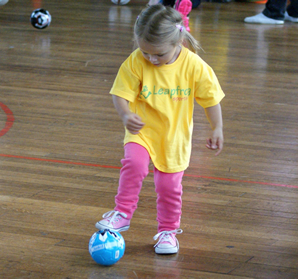Now, I don’t think I’ve mentioned it but Leapfrog Sports recently won an award.. best for getting active (we also came runners up in the Best for Toddlers too!)
I am very proud of this award because we really believe in the importance of getting children active, for both their physical and mental well-being. But do you know how much activity is recommended daily? Well read on to find out…
Physical activity is associated with numerous health benefits for children, such as muscle and bone strength, health and fitness, improved quality of sleep and maintenance of a healthy weight.
What are the guidelines?
Children under 5 who can walk on their own should be physically active every day for at least 180 minutes (three hours). This should be spread throughout the day, indoors or outside and is a mixture of light and energetic activity.
For children aged 5 to 18 years old to maintain a basic level of health, they need:
At least 60 minutes of physical activity every day – this should range from moderate activity, such as playground activities, to vigorous activity, such as running and tennis. On three days a week, these activities should involve exercises for strong muscles and bones, such as jumping and running.
These chief medical officers’ guidelines are thought to be so important that they are specifically referenced in the Early Years Foundation Stage Framework – which sets standards for the learning, development and care of children from birth to 5 years old, which all schools and Ofsted-registered early years providers must follow, including childminders, preschools, nurseries and school reception classes.
So what counts as the activity that is recommended in the guidelines?
I have mentioned a few above but light activity is things such as standing up, moving around and walking and the energetic activity that is needed are things that make kids ‘huff and puff’ such as:
- active play (like the games played at Leapfrog)
- running around
- jumping on a trampoline
- riding a bike
- dancing
- swimming
- skipping rope
- playing sport
This amount of time may be a challenge for busy parents, but there is evidence to show that early life experiences and habits impact upon our health as adults and of course, Leapfrog Sports sessions can make your life a little easier and help you achieve this.
Did you know that being active doesn’t just have physical benefits? Next time I’ll talk about how it can also help with children’s mental health…
Jo





 I am so proud and happy to announce that we are the WINNERS in the Hoop Awards 2018 category ‘Best for getting Active – Birmingham’!! and to make it even better we were runners up in the ‘Best for Toddlers – Birmingham’ category!
I am so proud and happy to announce that we are the WINNERS in the Hoop Awards 2018 category ‘Best for getting Active – Birmingham’!! and to make it even better we were runners up in the ‘Best for Toddlers – Birmingham’ category! Walking – Things to love about a walk is that it is free and easy – just step outside of your house, but not the most exciting activity. We have a dog (here she is!) so are always walking and a long walk is a great way for the family to get active with no cost involved and at any time. To make it more interesting we designate a leader and we take turns as to who decides which way to go, eg they might choose to go left or straight on down the road. We have also done scavenger hunts, where we look out for interesting objects on the way, you could even make a list of things to look for before you go eg leaves or bugs. You could even turn a walk into an obstacle course, eg balance on the cracks in the pavement, run to the lamppost. There is no excuse if it is raining either as just get your wellies on and see how many puddles you can jump in.
Walking – Things to love about a walk is that it is free and easy – just step outside of your house, but not the most exciting activity. We have a dog (here she is!) so are always walking and a long walk is a great way for the family to get active with no cost involved and at any time. To make it more interesting we designate a leader and we take turns as to who decides which way to go, eg they might choose to go left or straight on down the road. We have also done scavenger hunts, where we look out for interesting objects on the way, you could even make a list of things to look for before you go eg leaves or bugs. You could even turn a walk into an obstacle course, eg balance on the cracks in the pavement, run to the lamppost. There is no excuse if it is raining either as just get your wellies on and see how many puddles you can jump in. So firstly, my apologies! I know that last week I said that in this blog I would share some ways that you can get your children active and also the importance of children being active but we have had some fantastic news that I wanted to share…
So firstly, my apologies! I know that last week I said that in this blog I would share some ways that you can get your children active and also the importance of children being active but we have had some fantastic news that I wanted to share… sure you have come across these adverts from Cancer Research while you have been out and about, and everyday I seem to hear more and more stats about how the population is getting bigger and that soon being obese will be the new norm. It is clearly a problem and a growing problem caused by an energy imbalance: taking in more energy through food than we use through activity.
sure you have come across these adverts from Cancer Research while you have been out and about, and everyday I seem to hear more and more stats about how the population is getting bigger and that soon being obese will be the new norm. It is clearly a problem and a growing problem caused by an energy imbalance: taking in more energy through food than we use through activity.